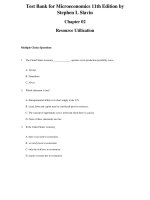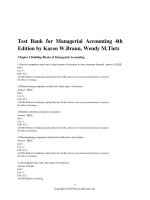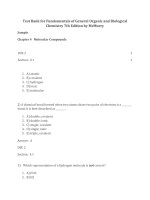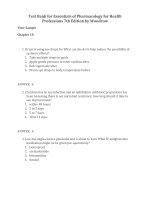link full download test bank for foundations of psychiatric mental health nursing a clinical approach 6th edition by varcarolis
Bạn đang xem bản rút gọn của tài liệu. Xem và tải ngay bản đầy đủ của tài liệu tại đây (275.91 KB, 16 trang )
Foundations of Psychiatric Mental Health Nursing Edition: 6th Test Bank –
Varcarolis
Sample
Elsevier items and derived items © 2010, 2006 by Saunders, an imprint of
Elsevier Inc.
Varcarolis: Foundations of Psychiatric Mental Health Nursing, 6th Edition
Chapter 09: Therapeutic Relationships
Test Bank
MULTIPLE CHOICE
1. A nurse assesses an elderly patient who was found wandering and confused.
The nurse
feels sad and reflects, “She’s like my grandmother…so helpless.” Which term
best applies to the nurse’s response?
a. Rapport
b. Transference
c. Countertransference
d. Defensive coping reaction
ANS: C
Countertransference is the nurse’s response to a patient that is based on the
nurse’s unconscious needs, conflicts, problems, or view of the world.
DIF: Cognitive Level: Comprehension REF: Text Page: 160
TOP: Nursing Process: Evaluation MSC: Client Needs: Psychosocial Integrity
2. Which statement shows a nurse has empathy for a patient who made a suicide
attempt?
a. “You must have been very upset to do what you did today.”
b. “It makes me sad to see you going through such a difficult experience.”
c. “If you tell me what is troubling you, I can help you solve your
problems.” d. “Suicide is a drastic solution to a problem that may not be
such a serious matter.”
ANS: A
Empathy permits the nurse to see an event from the patient’s
perspective, understand the
patient’s feelings, and communicate this to the patient. The distracters focus on
the nurse’s
feelings rather than the patient’s, promote patient dependence, and belittle
the patient’s
perspective.
DIF: Cognitive Level: Application REF: Text Page: 170
TOP: Nursing Process: Implementation MSC: Client Needs: Psychosocial Integrity
3. After several therapeutic encounters with a patient who recently
attempted suicide, which
behavior should cause the nurse to consider the possibility of countertransference?
a. The patient’s reactions toward the nurse seem realistic and appropriate.
b. The nurse feels very happy when the patient’s mood begins to lift.
c. The patient states, “Talking to you is like talking to my parents.”
d. The nurse develops a trusting relationship with the patient.
ANS: B
Strong positive or negative reactions to a patient or overidentification with
the patient signals
Test Bank
Elsevier items and derived items © 2010, 2006 by Saunders, an imprint of
Elsevier Inc.
9-2
possible countertransference. Nurses must carefully monitor their own feelings and
reactions
to detect countertransference, then seek supervision. The distracters
identify desirable
outcomes or transference.
DIF: Cognitive Level: Application REF: Text Pages: 107-108
TOP: Nursing Process: Evaluation MSC: Client Needs: Psychosocial Integrity
4. How should the nurse respond if a patient says, “Please don’t share information
about me
with the other people”?
a. “I cannot tell anyone about you. We can help each other by keeping it
between us.”
b. “I won’t share information with your family or friends without your
permission, but I will share information with other staff.”
c. “It depends on what you choose to tell me. I will be glad to disclose at the end
of each session what I will report to other staff.”
d. “Therapeutic relationships are between the nurse and the patient. It’s up to
you to
tell others what you want them to know.”
ANS: B
A patient has the right to know with whom the nurse will share information
and that
confidentiality will be protected. Although the relationship is primarily between
the nurse and
patient, other staff needs to know pertinent data. The relationship must be
patient centered and
have clear boundaries.
DIF: Cognitive Level: Application REF: Text Page: 164
TOP: Nursing Process: Implementation MSC: Client Needs: Psychosocial Integrity
5. A patient who recently attempted suicide talks with the nurse about wanting
to take a
walk on hospital grounds. The nurse responds by telling the patient, “I will
talk with the
psychiatrist on your behalf.” Select the accurate analysis of this
interaction. a. The nurse is behaving in an overly helpful way.
b. The nurse is showing positive regard for the patient.
c. The nurse is modeling healthy behaviors for the patient.
d. The patient has manipulated the nurse into taking this
action. ANS: A
Being overly helpful is a classic example of role boundary blurring. The
nurse’s response
does not reflect the modeling of healthy behavior. There is no data to indicate
the patient has
manipulated the nurse.
DIF: Cognitive Level: Application REF: Text Page: 161
TOP: Nursing Process: Evaluation MSC: Client Needs: Psychosocial Integrity
6. Termination of a therapeutic nurse-patient relationship has been successful when
the
nurse:
a. discusses with the patient changes that happened during the relationship
and evaluates outcomes.
b. gives the patient the nurse’s cell phone number and permission to call after
discharge.
Test Bank
Elsevier items and derived items © 2010, 2006 by Saunders, an imprint of
Elsevier Inc.
9-3
c. avoids upsetting the patient by shifting focus to other patients before the
patient’s
discharge.
d. offers to meet the patient for conversation after discharge.
ANS: A
Summarizing and evaluating progress help validate the experience for the
patient and the
nurse and facilitate closure. Termination must be discussed; avoiding discussion by
spending
little time with the patient promotes feelings of abandonment.
Successful termination requires
that the relationship be brought to closure without the possibility of dependencyproducing
ongoing contact.
DIF: Cognitive Level: Application REF: Text Page: 168
TOP: Nursing Process: Implementation MSC: Client Needs: Psychosocial Integrity
7. Select the desirable outcome for the initial stage of a nurse-patient
relationship. The
patient will demonstrate behaviors that
indicate: a. a greater sense of independence.
b. rapport and trust with the nurse.
c. resolved transference.
d. self-responsibility.
ANS: B
Development of rapport and trust is necessary before the relationship can progress
to the
working phase. The distracters present outcomes associated with the
working phase.
DIF: Cognitive Level: Comprehension REF: Text Pages: 166-167
TOP: Nursing Process: Planning/Outcomes Identification
MSC: Client Needs: Psychosocial Integrity
8. During which phase of the nurse-patient relationship can a nurse anticipate that
patient
issues will be explored and resolved?
a. Pre-orientation
b. Orientation
c. Working d.
Termination
ANS: C
During the working phase, the nurse strives to assist the patient in
making connections among
dysfunctional behaviors, thinking, and emotions and offers support while
alternative coping
behaviors are tried.
DIF: Cognitive Level: Comprehension REF: Text Pages: 167-168
TOP: Nursing Process: Planning MSC: Client Needs: Psychosocial Integrity
9. At what point in the nurse-patient relationship should a nurse first
address termination?
a. Preorientation phase
b. Orientation phase
Test Bank
Elsevier items and derived items © 2010, 2006 by Saunders, an imprint of
Elsevier Inc.
9-4
c. Working phase
d. Termination phase
ANS: B
The patient has a right to know the conditions of the nurse-patient relationship. If
the
relationship is to be time limited, the patient should be informed of the number of
sessions. If
it is open ended, the termination date will not be known at the outset, and
the patient should
know that the issue will be negotiated at a later date. Termination is usually
discussed during
the orientation phase. The nurse is responsible for discussing termination early in
the
relationship.
DIF: Cognitive Level: Comprehension REF: Text Pages: 163-166
TOP: Nursing Process: Implementation MSC: Client Needs: Psychosocial Integrity
10. Why should a nurse introduce the matter of a contract during the first
session with a new
patient? Contracts:
a. specify what the nurse will do for the patient.
b. spell out participation and responsibilities of both parties.
c. are indicative of the feeling tone established between the participants.
d. are binding and prevent either party from prematurely ending the
relationship. ANS: B
A contract emphasizes that the nurse works with the patient rather than
doing something for
the patient. “Working with” is a process that suggests each party is expected
to participate and
share responsibility for outcomes.
DIF: Cognitive Level: Comprehension REF: Text Page: 167
TOP: Nursing Process: Planning MSC: Client Needs: Psychosocial Integrity
11. A patient frequently asks the nurse for extra snacks, implying more
willingness to talk if
these items are provided. The nurse should assess this behavior as:
a. typical of transference reactions.
b. indicative of feelings of insecurity. c.
reflecting resistance to involvement. d.
testing the nurse’s clinical competence.
ANS: D
Patients often unconsciously use testing behaviors to determine whether the
nurse is able to
set limits or will abandon them if they behave in an unlikable way.
DIF: Cognitive Level: Application REF: Text Pages: 158; 161-162
TOP: Nursing Process: Assessment MSC: Client Needs: Psychosocial Integrity
12. Which remark by a patient indicates movement from orientation to the
working phase of
a nurse-patient relationship?
a. “I don’t have any problems.”
b. “It is so difficult for me to talk about problems.”
Test Bank
Elsevier items and derived items © 2010, 2006 by Saunders, an imprint of
Elsevier Inc.
9-5
c. “I don’t know how talking about things twice a week can help.”
d. “I want to find ways to deal with my anger without blowing up.”
ANS: D
Thinking about a more constructive approach to dealing with anger indicates a
readiness to
make a behavioral change. Behavioral change is associated with the working phase
of the
relationship. Denial or avoidance are often seen in the orientation
phase. DIF: Cognitive Level: Analysis REF: Text Pages: 166-168
TOP: Nursing Process: Evaluation MSC: Client Needs: Psychosocial Integrity
13. A nurse explains to the family of a mentally ill patient how the nursepatient relationship
differs from other interpersonal relationships. Which is the best explanation?
“The focus:
a. is on the patient. Problems are discussed by the nurse and patient, but solutions
are
implemented by the patient.”
b. shifts from nurse to patient as the relationship develops. Advice is given by
both and solutions implemented.”
c. is creation of a partnership in which each member is concerned with growth
and satisfaction of the other.”
d. of the relationship is socialization. Mutual needs are met and feelings are
shared openly.”
ANS: A
The distracters describe events that occur in social or intimate relationships.
Only the correct
answer describes elements of a therapeutic relationship.
DIF: Cognitive Level: Application REF: Text Pages: 157-159
TOP: Nursing Process: Implementation MSC: Client Needs: Psychosocial Integrity
14. A nurse wants to demonstrate genuineness with a patient diagnosed with
schizophrenia.
The nurse should:
a. use extensive self-disclosure in patient interactions.
b. encourage dependence on the nurse for support and reassurance.
c. consistently make interpretive judgments about the patient’s behavior.
d. be aware of own feelings and use congruent communication
strategies. ANS: D
Genuineness is a desirable characteristic involving awareness of one’s
own feelings as they
arise and the ability to communicate them when appropriate. The other
possible options are
undesirable in a therapeutic relationship.
DIF: Cognitive Level: Comprehension REF: Text Page: 169
TOP: Nursing Process: Implementation MSC: Client Needs: Psychosocial Integrity
15. A nurse caring for a withdrawn, suspicious patient recognizes development of
feelings of
anger toward the patient. The nurse should:
a. suppress the angry feelings.
Test Bank
Elsevier items and derived items © 2010, 2006 by Saunders, an imprint of
Elsevier Inc.
9-6
b. explore the anger openly and directly with the patient.
c. ask the nurse manager to assign the patient to another nurse. d.
discuss the anger with a clinician during a supervisory session.
ANS: D
The nurse is accountable for the relationship. Objectivity is threatened by
strong positive or
negative feelings toward a patient. Supervision is necessary to work
through countertransference feelings.
DIF: Cognitive Level: Application REF: Text Page: 158
TOP: Nursing Process: Evaluation MSC: Client Needs: Psychosocial Integrity
16. Which action by a nurse shows positive regard? a.
Making rounds according to the daily assignment. b.
Administering daily medication as prescribed.
c. Examining own feelings about a
patient. d. Staying with a patient who is
crying. ANS: D
Staying with a crying patient offers support and shows positive regard.
The distracters
describe tasks, not necessarily with positive regard, and the nurse’s efforts
to remain selfaware.
DIF: Cognitive Level: Application REF: Text Pages: 170-171
TOP: Nursing Process: Implementation MSC: Client Needs: Psychosocial Integrity
17. A nurse is talking with a patient, and 5 minutes remain in the session.
This patient has
been silent most of the session. Another patient interrupts and says to the nurse,
“I really
need to talk to you.” The nurse should:
a. invite the interrupting patient to join the session with the current patient.
b. tell the interrupting patient, “This session is 5 more minutes, then I will talk
with you.”
c. say to the interrupting patient, “I am not available to talk with you at the present
time.”
d. end the unproductive session with the current patient. Spend time with the next
patient.
ANS: B
When a specific duration for sessions has been set, the nurse must adhere to
the schedule.
Leaving the first patient would be abandonment and may destroy trust the patient
had in the
nurse. Adhering to the contract demonstrates that the nurse can be trusted and
that the patient
and the sessions are important. The distracters violate terms of the
contract. DIF: Cognitive Level: Application REF: Text Page: 165
TOP: Nursing Process: Implementation MSC: Client Needs: Psychosocial
Integrity Test Bank
Elsevier items and derived items © 2010, 2006 by Saunders, an imprint of
Elsevier Inc.
9-7
18. A patient says, “People should be allowed to commit suicide
without interference from
others.” A nurse replies, “You’re wrong. Nothing is bad enough to justify death.”
What is
the best analysis of this interchange?
a. The patient is correct.
b. Neither person is correct.
c. The statements reflect differing values.
d. The nurse has responded therapeutically.
ANS: C
Values guide beliefs and actions. The individuals stating their positions place
different values
on life and autonomy. Nurses must be aware of their own values and be sensitive
to the values
of others.
DIF: Cognitive Level: Comprehension REF: Text Pages: 163; 170-171
TOP: Nursing Process: Evaluation MSC: Client Needs: Psychosocial Integrity
19. Which issues should a nurse address during the first interview with a
patient with a
psychiatric disorder?
a. Trust, congruence, attitudes, and boundaries.
b. Goals, resistance, unconscious motivations, and diversion.
c. Relationship parameters, the contract, confidentiality, and termination.
d. Transference, countertransference, intimacy, and developing
resources. ANS: C
Relationship parameters, the contract, confidentiality, and termination should
be considered
during the orientation phase of the relationship. The distracters represent
issues dealt with
later.
DIF: Cognitive Level: Comprehension REF: Text Page: 166
TOP: Nursing Process: Planning MSC: Client Needs: Psychosocial Integrity
20. A psychiatric nurse visits one particular patient before work, seeks out
the patient during
the shift, and spends a few minutes with the patient after going off duty. Which
analysis
is accurate? The nurse is:
a. overinvolved.
b. expressing anger.
c. experiencing transference.
d. looking to be rescued.
ANS: A
The nurse behavior described is typical of overinvolvement. There are no data
to support the
distracters.
DIF: Cognitive Level: Comprehension REF: Text Page: 161
TOP: Nursing Process: Evaluation MSC: Client Needs: Psychosocial Integrity
Test Bank
Elsevier items and derived items © 2010, 2006 by Saunders, an imprint of
Elsevier Inc.
9-8
21. Which behavior shows that a nurse values autonomy? The nurse:
a. sets limits on a patient’s romantic overtures toward the nurse.
b. suggests one-on-one supervision for a patient who is suicidal.
c. informs a patient that the spouse will not be in during visiting hours.
d. discusses alternatives and helps the patient weigh the
consequences. ANS: D
A high level of valuing is acting on one’s belief. Autonomy is evident when the
nurse helps
patient weigh alternatives and their consequences before the patient makes a
decision.
Autonomy or self-determination is not the issue in any of the other
behaviors. DIF: Cognitive Level: Application REF: Text Page: 163
TOP: Nursing Process: Implementation MSC: Client Needs: Psychosocial
Integrity 22. A nurse provided psychiatric home care services to a patient for 6
months, but now the
patient will begin a psychosocial rehabilitation program. On the nurse’s final home
visit,
the patient gives the nurse a gold angel pin and says, “Thank you for being
my guardian
angel when I needed help.” Select the nurse’s best response.
a. “I’m happy you have made so much improvement. Thank you for the pin.”
b. “Our agency’s policies and procedures prohibit me from accepting your gift.”
c. “All nurses care. It’s rewarding when patients recognize how hard we work.”
d. “I’m glad you’ve made progress and that I helped, but I cannot accept the gift.”
ANS: D
Accepting a gift creates a social rather than therapeutic relationship with
the patient and blurs
the boundaries of the relationship. A caring nurse will acknowledge the patient’s
gesture of
appreciation, but this gift should not be accepted. DIF:
Cognitive Level: Analysis REF: Text Page: 165
TOP: Nursing Process: Implementation MSC: Client Needs: Psychosocial Integrity
23. A patient says, “I’m still on restriction, but I want to attend some offunit activities.
Would you ask the doctor to change my privileges?” Select the nurse’s best
response.
a. “I’ll be glad to mention it when I see the doctor today.” b.
“That’s a good topic for you to take up with your doctor.”
c. “Why are you asking me when you’re able to speak for yourself?”
d. “I’m glad you feel comfortable asking me to help you with that request.”
ANS: B
Nurses should encourage patients to work at their optimal level of functioning.
The nurse does
not act for the patient unless necessary. Acting for a patient increases feelings
of helplessness
and dependency.
DIF: Cognitive Level: Application REF: Text Pages: 161; 164-165
TOP: Nursing Process: Implementation MSC: Client Needs: Psychosocial Integrity
Test Bank
Elsevier items and derived items © 2010, 2006 by Saunders, an imprint of
Elsevier Inc.
9-9
24. A community mental health nurse has worked with a patient for 3 years but
is moving
and must terminate the relationship. When a new nurse begins work with this
patient,
what is the starting point for the relationship?
a. Begin at the orientation phase
b. Continue the working relationship
c. Start with informal social interactions
d. Return to the emotional catharsis
phase ANS: A
After termination of a long-term relationship, the patient and new nurse usually
have to begin
at ground zero, the orientation phase, to build a new relationship. If termination is
successfully completed, the orientation phase sometimes progresses quickly to
the working
phase. Other times, even after successful termination, the orientation phase may
be prolonged.
DIF: Cognitive Level: Application REF: Text Pages: 166-168
TOP: Nursing Process: Planning MSC: Client Needs: Psychosocial Integrity
25. The nurse tells a peer, “I feel very uncomfortable with a patient and find myself
wanting
to avoid both informal contacts and scheduled sessions.” Without
supervision, which
outcome is likely?
a. Growing interest and mutuality
b. Mutual withdrawal
c. Positive regard
d. Trust
ANS: B
A nurse’s negative preconceived ideas about a patient and negative feelings
toward the patient
usually result in frustration and mutual withdrawal. Supervision would cause
the nurse to
explore the origins of the feelings and make changes as necessary. The other
options suggest
positive outcomes, which rarely occur in the face of negative feelings on the part
of the nurse.
DIF: Cognitive Level: Application REF: Text Pages: 158; 161-162
TOP: Nursing Process: Evaluation MSC: Client Needs: Psychosocial Integrity
26. A nurse believes, “I’m the only one who truly understands this patient.
Other staff
members are too critical.” Which situation is
evident? a. Boundary blurring
b. Sexual harassment
c. Positive regard
d. Transference
ANS: A
When the role of the nurse and the role of the patient shift, boundary blurring
may arise. In
this situation, the nurse is becoming overinvolved with the patient as a probable
result of
unrecognized countertransference. When boundary issues occur, the need for
supervision
exists. The situation does not describe sexual harassment. Data are not present
to suggest
positive regard or transference.
Test Bank
Elsevier items and derived items © 2010, 2006 by Saunders, an imprint of
Elsevier Inc.
9-10
DIF: Cognitive Level: Comprehension REF: Text Pages: 158-162
TOP: Nursing Process: Evaluation MSC: Client Needs: Psychosocial Integrity
27. As a patient with mental illness is discharged from a facility, the nurse
invites the patient
to the annual staff holiday party. Select the best analysis of this scenario.
a. The invitation facilitates dependency on the nurse.
b. The nurse’s action blurs the boundaries of the therapeutic relationship. c.
The invitation is therapeutic for the patient’s diversional activity deficit. d.
The nurse’s action assists the patient’s integration into community living.
ANS: B
The invitation creates a social rather than therapeutic relationship. It may or
may not increase
dependency on the nurse.
DIF: Cognitive Level: Application REF: Text Pages: 157-159
TOP: Nursing Process: Evaluation MSC: Client Needs: Psychosocial Integrity
28. As a nurse discharges a patient, the patient gives the nurse a card
of appreciation made in
an arts and crafts group. Select the nurse’s best action.
a. Recognize the patient’s thoughtfulness. Express appreciation and accept
the card.
b. Inform the patient that accepting gifts violates policies of the facility.
Decline the
card.
c. Acknowledge the patient’s transition through the termination phase, but
decline the
card.
d. Accept the card. Invite the patient to return to participate in other arts and
crafts groups.
ANS: A
The nurse must consider the meaning, timing, and value of the gift. In
this instance, the nurse
should accept the patient’s expression of gratitude.
DIF: Cognitive Level: Application REF: Text Page: 165
TOP: Nursing Process: Implementation MSC: Client Needs: Psychosocial Integrity
29. During the first interview, a nurse notices that a patient does not make
eye contact. Which
analysis is correct?
a. The patient is not truthful and is demonstrating evasive behavior.
b. The patient is shy. The nurse should progress slowly.
c. The patient feels sad and cannot look at the
nurse. d. More information is needed to draw a
conclusion. ANS: D
The data presented are insufficient to draw a conclusion. The nurse must
continue to gather
information.
DIF: Cognitive Level: Application REF: Text Pages: 166-167
TOP: Nursing Process: Assessment MSC: Client Needs: Psychosocial
Integrity Test Bank
Elsevier items and derived items © 2010, 2006 by Saunders, an imprint of
Elsevier Inc.
9-11
MULTIPLE RESPONSE
1. Which nursing actions demonstrate consistency and reliability? (Select all that
apply.)
a. Providing a schedule of daily activities.
b. Offering solutions to a patient’s problems.
c. Having the same nurse care for a patient daily. d.
Setting a time for regular sessions with a patient.
e. Encouraging a patient to share initial impressions of
staff. ANS: A, C, D
Consistency implies predictability. The correct answers help a patient predict
what will
happen during each day and develop a greater degree of security and comfort.
Encouraging a
patient to share initial impressions of staff and giving advice are not related
to consistency and
would not be considered therapeutic interventions.
DIF: Cognitive Level: Application REF: Text Page: 157
TOP: Nursing Process: Implementation MSC: Client Needs: Psychosocial Integrity
2. A nurse ends a relationship with a patient. Which action(s) by the nurse should
be
included in the termination phase? (Select all that apply.)
a. Establish expectations of how long the relationship will last.
b. Work with the patient to identify strengths, limitations, and problems.
c. Help the patient express feelings about the relationship with the nurse.
d. Help the patient prioritize and modify socially unacceptable behaviors.
e. Focus dialogues with the patient on problems that may develop in the future.
ANS: C, E
These actions are part of the termination phase. The other actions apply to the
orientation or
working phases.
DIF: Cognitive Level: Application REF: Text Page: 168
TOP: Nursing Process: Implementation MSC: Client Needs: Psychosocial Integrity
3. A psychiatric nurse’s parent had bipolar disorder. The nurse angrily
recalls childhood
memories of embarrassment about the parent’s behavior. Select the best
coping strategies
for this nurse. (Select all that apply.)
a. Seek ways to use the understanding gained from childhood to help patients cope
with their own illnesses.
b. Recognize that these feelings are unhealthy. The nurse should repress
them when
working with patients.
c. Recognize that psychiatric nursing is not an appropriate career choice.
Select another area of practice.
d. Begin relationships with new patients by saying, “My parent had mental
illness, so
I accept it without stigma.”
e. Recognize that the feelings may add sensitivity to the nurse’s practice,
but supervision is important.
Test Bank
Elsevier items and derived items © 2010, 2006 by Saunders, an imprint of
Elsevier Inc.
9-12 ANS:
A, E
The nurse needs support to explore these feelings. An experienced psychiatric
nurse is a
resource who may be helpful. The knowledge and experience gained from
the nurse’s
relationship with a mentally ill parent may contribute sensitivity to
compassionate practice.
Self-disclosure and suppression are not adaptive coping strategies. The nurse
should not give
up on this area of practice without first seeking ways to cope with the memories.
DIF: Cognitive Level: Application REF: Text Pages: 158-160; 170-171
TOP: Nursing Process: Implementation MSC: Client Needs: Psychosocial Integrity









